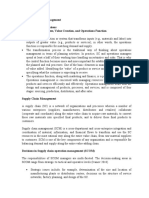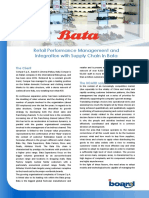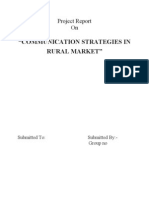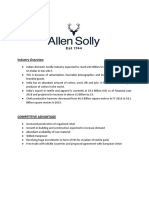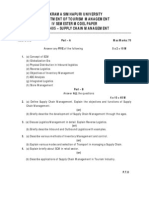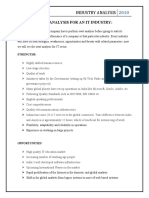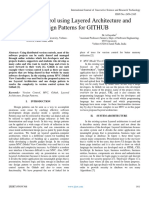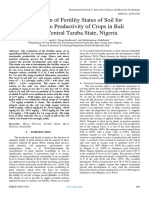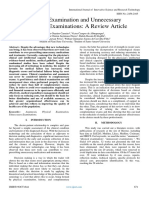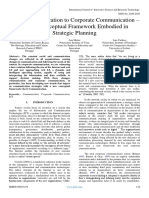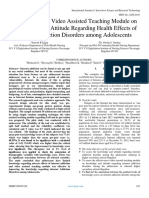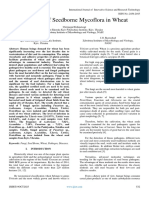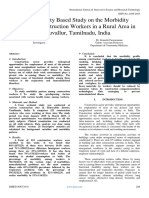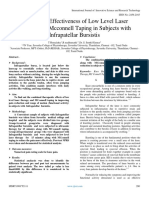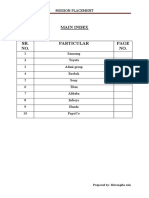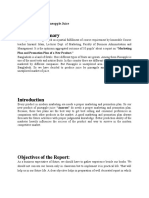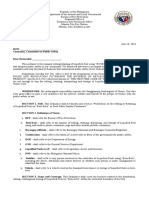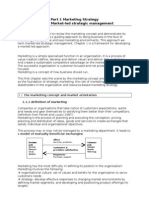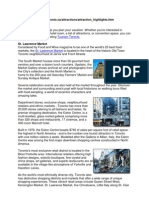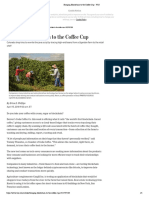Professional Documents
Culture Documents
Application of Operations Research in Supply Chain Management of FMCG Industry
Uploaded by
Anonymous lAfk9gNPCopyright
Available Formats
Share this document
Did you find this document useful?
Is this content inappropriate?
Report this DocumentCopyright:
Available Formats
Application of Operations Research in Supply Chain Management of FMCG Industry
Uploaded by
Anonymous lAfk9gNPCopyright:
Available Formats
Volume 4, Issue 10, October – 2019 International Journal of Innovative Science and Research Technology
ISSN No:-2456-2165
Application of Operations Research in Supply Chain
Management of FMCG Industry
Sinjini De Sarkar, Sakshi Kanchan, Shaurya Manohar, Saumya Patodia, Senthil Ramachandran
Abstract:- It is essential for FMCG companies to profit margins of FMCG goods. Therefore , using
manage their supply chain by reducing costs and at the operations research tactics on supply chain management on
same time maintaining quality of their products. In this FMCG goods is important as they will make sure that the
paper we have tried to explore ways in which we can products are profitable while also ensuring that the
make a small aspect of supply chain a little more products are available at the right place at the right time.
efficient, and sustainable in the process. The first
technique looks at how to optimize the delivery of For example linear programming models can be used
products to minimize costs. This includes finding out to reduce the production, distribution and the inventory
number of units to be transported so that demand as costs while maximising profits. Here we are also going to
well as supply is satisfied. The second technique assume perishability of products is also an important factor
analyses the product mix that should exist within a to be considered while optimizing the problem. This is
truck to maximize weight constraints and reduce because the retailers will expect to have a certain amount of
number of delivery times. The third technique used is shelf life left when they receive the product. Therefore, the
the vehicle routing method, to account for efficient only a part of the shelf life can be used up during the
logistics taking into consideration time and cost supply chain process. Also another reason is because if
constraints. shelf life is not considered then some of the goods may
exceed shelf life period causing the company extra disposal
Keywords:- Supply Chain Management, FMCG, costs. Due to this some of the demand will not be utilised.
Transportation Problem, Linear Programming, Vehicle This will cause loss of missed sales.
Routing, Sustainability.
II. OVERVIEW OF THE INDUSTRY
I. INTRODUCTION
Most authors have emphasised on the broad scope of
“Liquidity constraints and lower farm incomes will supply chain as a systems in the value chain far beyond just
likely affect revenues at India’s leading consumer the traditional production-to-customer concept. Supply
companies.” Economic Times (Sagar Malviya, Sanam chain management covers the processes of demand
Mirchandani, 2019)s. The FMCG is facing a huge management, manufacturing planning and scheduling,
slowdown in the past 4 quarters due to the reducing inventory management, order processing and fulfilment,
consumption in the rural market. The consumers are warehousing, transportation, distribution management,
shifting Towards cheaper and local daily essential goods in import/export management, product development,
the urban and the rural market. The statistic shows that the promotions planning, and customer service. (Gupta,
revenue earned has fallen from 16.5% in the July- Managing Supply Chain in Indian FMCG Sector , 2002). A
September in 2018 to a 2 year low of 10% in the June customer-focused definition is given by Hines (2004:p76):
quarter this year. Even the FMCG index in BSE has "Supply chain strategies require a total systems view of the
dropped by 7.4% in 2019. All of the above facts are links in the chain that work together efficiently to create
indicating to economic slowdown in the near future for the customer satisfaction at the end point of delivery to the
FMCG sector in India. consumer. As a consequence, costs must be lowered
throughout the chain by driving out unnecessary expenses,
Fast Moving Consumer Goods (FMCG) are movements, and handling. The main focus is turned to
commonly named as consumer packaged goods. Items in efficiency and added value, or the end-user's perception of
this category include all types of consumables other than value. Efficiency must be increased, and bottlenecks
groceries/pulses. The FMCG products are normally used up removed. The measurement of performance focuses on
within a short amount of time.it ranges between a couple of total system efficiency and the equitable monetary reward
days to a year. Therefore they are quickly substituted when distribution to those within the supply chain. The supply
they are not available. Due to this large quantity of goods chain system must be responsive to customer
are sold which gives a high profit margin despite the low requirements.”
IJISRT19OCT1892 www.ijisrt.com 303
Volume 4, Issue 10, October – 2019 International Journal of Innovative Science and Research Technology
ISSN No:-2456-2165
Fig 1:- Supply Chain for a Manufacturing Organization (Supply Chain Management ) by Welingkar
Fig 2:- Supply Chain for a Service Organization (Supply Chain Management ) by Welingkar
Fast-moving consumer goods (FMCG) and, due to time constraints, barely get time for cooking.
Sector is the 4th largest sector in the Indian economy (IBEF, 2019)
with Household and Personal Care accounting for 50 per
cent of FMCG sales in India. Growing awareness, easier Thus Supply Chain management using quantitative
access and changing lifestyles have been the key growth methods is about optimizing the millions of decisions that
drivers for the sector. The urban segment (accounts for a need to be made by the company every day, computers
revenue share of around 55 per cent) is the largest play a central role in this undertaking. SCM at present is
contributor to the overall revenue generated by the FMCG about taking digitalization one step further.
sector in India.
To some extent, Quantitative Supply Chain was born
Rural consumption has increased, led by a out of those mistakes: instead of pretending that the system
combination of increasing incomes and higher aspiration somehow knows the business better that its own
levels; there is an increased demand for branded products management, the focus needs to place on executing the
in rural India. The rural FMCG market in India is expected insights generated by the management, but with a higher
to grow to US$ 220 billion by 2025 from US$ 23.6 billion degree of reliability, clarity and agility. Software
in FY18. In FY18, FMCG’s rural segment contributed an technology done right is a capable enabler, but, considering
estimated 10 per cent of the total income and it is the present capabilities of software, removing people
forecasted to contribute 15-16 per cent in FY 19. FMCG entirely from the solution isn’t a realistic option.
sector is forecasted to grow at 12-13 per cent between (Lokad.com, n.d.)
April–June 2019.
III. RESEARCH OBJECTIVES
On the other hand, with the share of unorganised
market in the FMCG sector falling, the organised sector 1. To understand the overall value generated by the levels
growth is expected to rise with increased level of brand of value chain of the product by increasing the
consciousness, also augmented by the growth in modern efficiency of supply chain using OR techniques.
retail. 2. To discuss possible reduction in supply chain costs by
working on logistics and truck turnaround time.
Another major factor propelling the demand for food 3. To elaborate on possible application and knowledge of
services in India is the growing youth population, primarily supply chain management to reach the maximum
in the country’s urban regions. India has a large base of possible consumer group in the FMCG sector.
young consumers who form the majority of the workforce
IJISRT19OCT1892 www.ijisrt.com 304
Volume 4, Issue 10, October – 2019 International Journal of Innovative Science and Research Technology
ISSN No:-2456-2165
4. To find applications of sustainable methods in supply The possibilities of applying Operations Research
chain to help FMCG industry work towards a more (O.R.) techniques in the design of real-world systems are
green model. vast. The optimization and design of the supply chain
network (SCN) is one of the relevant topics that has
IV. RESEARCH METHODOLOGY directed the attention of many scholars. Sound decisions in
this regard, including the proper selection of the facility’s
We have referred to 12 research papers and 5 articles location, transportation modes and routes and inventory
related to supply chain management in various industries management policies, can noticeably improve the systems
for the purpose of understanding the processes and applied performance. We have relied on secondary data for our
the concepts to write our paper on supply chain in FMCG paper on the basis of current practices adopted by
industry. We have only used secondary data as a means of conglomerates and the upcoming FMCG companies to
data collection. The first technique used is transportation increase the scope of their supply chain to integrate
problem and formulated the same using references from a sustainability as well as cost- effectiveness into the models.
research paper. The second technique used is Linear
Programming Problem where-in we have formulated the VI. FINDINGS AND ANALYSIS
equation to show how to optimize truck utility. And thirdly
we have explored vehicle routing problem to minimise time A. Transportation Problem: (Federal, 2014)
and cost utilisation. We have also written about the future Transportation problem is a type of linear
capacity of a sustainable supply chain management system. programming problem with the objective of minimizing the
cost of distribution of a product from a number of sources
V. LITERATURE REVIEW say for eg warehouses to the destinations which could be
retail outlets. In the case of supply chain problems,
Supply chain has been a topic of wide discussion and transportation problem methods can be used to identify the
importance ever since the advent of the Industrial best possible methods through which we can satisfy
revolution. This is simply because of the fact that supply demand taking into consideration supply constraints at the
chain has increased its definition by leaps during the past minimum cost possible.
two decades. FMCG is the sector that caters to the biggest
demographic pool in the world and thus has been a point of To demonstrate how the technique can be used we
contention for increasing its efficiency and effectiveness to assume an FMCG company subsidiary ABC Ltd.
the maximum communities in the world. All FMCG
companies follow a point of contention to increase their The company has 4 plants and 5 retail outlets. The
sales by playing on their reach in deeper markets of India following outlines the transportation problem table.
as these are inelastic products, and even a slight change in
price could trigger a price war within the big players in the 1 2 3 4 5 Supply
market. Though the consumers could benefit from the A 960 720 1080 1200 480 15
same, this would resist the entry and sustainability of
smaller players. That is when these companies try to B 672 792 864 1080 624 15
instead tweak their production cost ,i.e., cost incurred in the C 1008 864 1584 360 552 15
supply chain process. Transportation cost represents D 1272 792 528 288 864 15
approximately 40 to 50 percent of total logistic costs and 4
to 10 percent of the product selling price for many Demand 8 12 10 11 19
companies. (P.Shirisha, 2014). Therefore, transportation Table 1
decisions directly affect the total logistic costs.
Transportation being an important component of supply A, B, C, D are the supply centres in the warehouses
chain competitiveness has also been a major focus area for 1, 2, 3, 4, 5 are the retail outlets.
studies by authors on refining the efficiency using The cost consists of transporting goods in each truck.
operations research. The transportation cost is assumed to be Rs 12 per mile
which consists of maintenance, fuel, personnel and
One of the constructs to improve supply chain loading on and off.
efficiency is to look at truck utilization. (Joris van de This cost is multiplied by the distance between each
Klundert, 2011)explore different models to improve the supply and demand centre and multiplied by 2 to get
Less than Truckload (LTL) utilization. The argue that the roundabout cost.
motive is to increase the vehicle utilization of already
scheduled road transportation activities which not just After solving this particular transportation problem,
benefits the freight sender by reducing costs but also we can arrive at the best possible allocations of truck routes
reduces congestion and pollution for the society at large. with lowest cost.
These models were established and put into practice with
the help of O.R. techniques and finally refined by AI in the
modern days.
IJISRT19OCT1892 www.ijisrt.com 305
Volume 4, Issue 10, October – 2019 International Journal of Innovative Science and Research Technology
ISSN No:-2456-2165
B. Linear Programming Problem: (Chikhalkar) (Banik, The first problem is to vehicles to customers, where
2011) either multiple vehicles need to be delivered to a
In our research paper we have used Linear customer, multiple destinations, where one customer
Programming Model to decide what product mix to put on needs to be served more than once etc.
a truck to either minimize weight, volume or floor position. The second kind of problem arises when we need to
In our research we have decided the objective function to create sequences in cases where trucks need to deliver
be minimization of weight however it could be either of the to customers as well as pick up goods from certain
other two as well. places. This means finding out the ways in which trucks
can get to the assigned destinations keeping constraints
In this study we pick a particular customer who has such as order of delivery in mind.
enough demand or orders to formulate the linear The third kind of problem deals with time constraints
programming problem. In our case we have assumed the with respect to the customer.
customer to have order 5 shipments in a period of one
month. The three ways in which we can help solve the
problems are,
To create the linear programming problem we define Vehicle Flow Formulation : Integer Variables are used
the objective function along with the constraints. More to find the solution.
weight is allocated to the initial shipments and then Commodity Flow Formulations : Additional Integer
decreased as the shipments increase. This is called Variables are used to take into consideration flow of
decreasing-weighted average objective function. This is commodities.
done to maximize the weight progressively. Set Partitioning Problem : Developing the Set Partition
Formulation In the SPP formulation each of the
Objective Function : columns represent a (feasible) route, and each of the
5(Truck 5 Xi* Weight) + 4(Truck 4 Xi* Weight) + rows represent a customer. So aij = 1 if customer i is
3(Truck 3 Xi* Weight) + 2*(Truck 2 Xi* Weight) + included into route j. For each subset of customers Sj
1*(Truck 1 Xi * Weight) the cost cj is determined by solving a Transportation
Problem over the customers.
Xi are SKU decision variables and Xi is binary with 1
representing that a SKU has been selected for a shipment, VII. SUSTAINABILITY IN SUPPLY CHAIN
or 0 representing that that SKU has not been selected for a MODELS
shipment.
Supply chain is the first link of the manufacturing
Subject to constraints : industry to its output and hence provides the possibilities to
Weight : ∑Wi * Xi ≤ 50000 say gain a factorial-fold gains from incorporating sustainable
Volume : ∑Vi * Xi ≤ 5000 say practices at this stage of the value chain.
Floor Position : ∑F * Xi ≤ 30 say
As and how supply chain management (SCM) added
Using this objective subject to these constraints we to its scope of definition, different policies and means have
can find out the optimal number of trucks by maximizing been taken into consideration for increasing competence of
weight which could eventually result in a decrease of the SCM activities. The emergence of lean Supply Chain
number of trucks required and hence cost of transportation. brought in the established concept of efficient utilization,
where cost reduction, flexibility and process improvement
C. Vehicle Routing Problem (Shukla, 2017) were targeted through the minimization of different types
This technique is used to find out the optimal route of wastes in the system. After a few years, agility was
that can be used taking into consideration time and cost introduced as a competency with the aim of developing an
minimization. Under vehicle routing problem there arises Supply Chain with a high ability to respond to the market
three kinds of problems. changes.
Fig 3
IJISRT19OCT1892 www.ijisrt.com 306
Volume 4, Issue 10, October – 2019 International Journal of Innovative Science and Research Technology
ISSN No:-2456-2165
These models have been put in place with a manufacturing sector which could make or break a
significant success rate ranging from providing both sustained growth trajectory.
economic and environmental aid. Since the Paris Peace
Agreement, climate change and global warming has The following numbers elaborate that to cut their
become the major concerns of international society leading emissions in line with the Paris target while increasing
to a surge in scientific and technological solutions for sales at the projected rate of 5.3 percent a year, FMCG
various business aspects. The ‘green’ concept has evolved companies would have to lower their carbon intensity—the
rapidly to reduce pollution and the negative environmental amount of greenhouse gas emitted per unit of output—by
impacts of Supply Chain activities. Supply chain efficiency more than 90 percent between 2015 and 2050. (Swartz,
have proved benefits for profitability and is soon going to n.d.)
be the differentiating factor for both the service and
Fig 4
VIII. CHALLENGES also that how long will the product last at the customers
shelf. However this can be solved using the vehicular
Shelf Life routing model.
Not all FMCG products have a good shelf life. A lot
of these products need to from producer to retailer to For example- A grocery store owner figures out that
customer within a couple of days. This makes the linear buying a particular product having a shelf life for 5 days
programming and the transportation problems more from seller A is more efficient than buying it from seller B.
complicated as it adds a time constraint to it as well. The He also finds out that seller A takes 3-4 days to get the
business owners now have to bring into consideration that product from the manufacturer/farmer whereas Seller B
for how long can the product stay in their own shelfs and takes only 2-3 days. The grocery store owner might prefer
IJISRT19OCT1892 www.ijisrt.com 307
Volume 4, Issue 10, October – 2019 International Journal of Innovative Science and Research Technology
ISSN No:-2456-2165
seller B as the product might expire even before he could [5]. Sagar Malviya, Sanam Mirchandani. (2019,
sell or it might expire after one day after the customer buys september 19). The Economic Times. Retrieved from
the product. The Economic Times:
https://economictimes.indiatimes.com/industry/cons-
New Technology products/fmcg/worst-fmcg-show-likely-in-15-years-
Operations research was made easier by developing credit-suisse/articleshow/71193810.cms?from=mdr
advanced computer and machines. It made easier for [6]. Supply Chain Management . (n.d.). Welingkar.
business owners to find the best routes and ways to [7]. P.Shirisha, G. K. (2014).
transport the products. Technology has grown even more [8]. Chikhalkar, R. (n.d.). Analyse and design an Efficient
and instead of helping the growth of complimenting Logistics System.
operations research, it’s working towards substituting [9]. Banik, J. (2011). Modeling Order Guidelines to
operations research. Improve Truck Utilization. Massachusetts Institute of
Technology.
Automated truck loading system, a method [10]. Federal, A. I. (2014). Supply Chain Management
companies are working on where the trucks will be docked Optimization Problem.
to the machines at the factory. These machines will put the [11]. Shukla, H. (2017). Application of Operations
products directly into the truck according to the orders. Research in Logistics and Warehouse Optimization.
This is expected to work by 2025 and will completely [12]. Joris van de Klundert, B. O. (2011).
nullify the use of OR in this particular scenario. [13]. Swartz, A.-T. B. (n.d.). McKinsey.com. Retrieved
from https://www.mckinsey.com/business-
IX. LIMITATIONS functions/sustainability/our-insights/starting-at-the-
source-sustainability-in-supply-chains
Inadequate time to research well enough about the
supply chain pertaining specifically to FMCG products.
Lack of technical knowledge on how to simulate real
life situations to give a more holistic perspective into
the working of the supply chain.
Limited access to related research papers and journals
and other such resources to deepen our knowledge of
the entire system.
X. CONCLUSION
This research paper attempts at finding out the most
obvious problems and summarizing how it could be solved.
It shows that trucks are not fully optimized according to
their weight, volume and floor capacity and companies
could look into optimizing either one of them or in
combination to optimize the delivery and reduce costs. It
also looks into problems of finding best possible routes and
sequence of routes to satisfy not only the order but also the
time constraints.
REFERENCES
[1]. Gupta, B. S. (2020, January). Retrieved from
https://www.researchgate.net/publication/287813236
_Supply_Chain_Management_in_Indian_FMCG_Sec
tor
[2]. Gupta, B. S. (2002, January). Retrieved from
Managing Supply Chain in Indian FMCG Sector :
https://www.researchgate.net/publication/287813236
_Supply_Chain_Management_in_Indian_FMCG_Sec
tor
[3]. IBEF. (2019, August). Retrieved from
https://www.ibef.org/industry/fmcg.aspx
[4]. Lokad.com. (n.d.). Retrieved from
https://www.lokad.com/introduction-to-quantitative-
supply-chainv
IJISRT19OCT1892 www.ijisrt.com 308
You might also like
- Implementation of SCM Practices in Indian FMCG IndustryDocument18 pagesImplementation of SCM Practices in Indian FMCG Industryabysbaby123No ratings yet
- Ojit 240619Document5 pagesOjit 240619Gaurav kumarNo ratings yet
- Fast Moving H&M: An Analysis of Supply Chain Management: Manvinder Singh Rathore, Kriti Maheshwari, Shreyans JainDocument12 pagesFast Moving H&M: An Analysis of Supply Chain Management: Manvinder Singh Rathore, Kriti Maheshwari, Shreyans JainEmaNo ratings yet
- SEO-Optimized Title for Biscuit Industry DocumentDocument51 pagesSEO-Optimized Title for Biscuit Industry Documentparul198840% (5)
- Toyota's Lean Supply ChainDocument5 pagesToyota's Lean Supply ChainVINEET MATHURNo ratings yet
- Nestle ReportDocument59 pagesNestle Reportmonika_yadavNo ratings yet
- Balance ScorecardDocument21 pagesBalance Scorecardfixs2002100% (1)
- OM Study at HCL InfosystemsDocument20 pagesOM Study at HCL InfosystemsMrinal KalitaNo ratings yet
- The HR Intervention at Rourkela Steel PlantDocument15 pagesThe HR Intervention at Rourkela Steel PlantMonojeet Chakravorty50% (2)
- Global Supply Chain Management - NotesDocument10 pagesGlobal Supply Chain Management - NotesShawkat Tanveer RahmanNo ratings yet
- Bata Case StudyDocument3 pagesBata Case StudyNina_C_ALNo ratings yet
- Fresh-Soybean-Oil-of-Meghna-group of IndustriesDocument26 pagesFresh-Soybean-Oil-of-Meghna-group of IndustriesSharmin SultanaNo ratings yet
- An Insight On The Working of JIT in Indian Automobile IndustriesDocument30 pagesAn Insight On The Working of JIT in Indian Automobile IndustriesHimanshu SangaNo ratings yet
- BUSINESS RESEARCH METHODS: FACTORS INFLUENCING BRAND SWITCHING IN TELECOM INDUSTRYDocument16 pagesBUSINESS RESEARCH METHODS: FACTORS INFLUENCING BRAND SWITCHING IN TELECOM INDUSTRYNeena TomyNo ratings yet
- Retail Management: Submitted To, Submitted ByDocument18 pagesRetail Management: Submitted To, Submitted ByShristi DubeyNo ratings yet
- Supply Chain Management Case StudyDocument2 pagesSupply Chain Management Case StudyLeonidNo ratings yet
- Assignment Supply Chain Management BY Virupaksha Reddy.T ROLL NUMBER: 510916226 OM0003 SET-1Document12 pagesAssignment Supply Chain Management BY Virupaksha Reddy.T ROLL NUMBER: 510916226 OM0003 SET-1virupaksha12No ratings yet
- Business Analytics Canvas On Water Management in BengaluruDocument11 pagesBusiness Analytics Canvas On Water Management in BengaluruJyothish JbNo ratings yet
- Project Report On Communication Strategies in Rural MarketDocument53 pagesProject Report On Communication Strategies in Rural Marketzrd_1250% (2)
- Performance Appraisal Practices in Hospitality Industry in New Delhi An Exploratory Study Ijariie1738Document12 pagesPerformance Appraisal Practices in Hospitality Industry in New Delhi An Exploratory Study Ijariie1738AviJainNo ratings yet
- Organisation Study: - at at "United Timber Corporation'', ThammanamDocument15 pagesOrganisation Study: - at at "United Timber Corporation'', ThammanamAlthaf MahinNo ratings yet
- Li & Fung Global Supply ChainDocument19 pagesLi & Fung Global Supply ChainTarun UraiyaNo ratings yet
- Vertical Integration in Apparel IndustryDocument15 pagesVertical Integration in Apparel IndustryAyushi ShuklaNo ratings yet
- EFE... and External AuditDocument21 pagesEFE... and External Auditvicky_00753No ratings yet
- Assignment On International Logistics Mangement 2Document6 pagesAssignment On International Logistics Mangement 2Subham ChakrabortyNo ratings yet
- Order Winner and Order QualifiersDocument10 pagesOrder Winner and Order QualifiersAmol AmraleNo ratings yet
- 7Ps Drive Rural Microfinance in IndiaDocument2 pages7Ps Drive Rural Microfinance in IndiaVaibhav Wadhwa0% (1)
- IV Sem MBA - TM - Supply Chain Management Model Paper 2013Document2 pagesIV Sem MBA - TM - Supply Chain Management Model Paper 2013vikramvsu0% (1)
- Study of Human Resource Challenges at E-Commerce Industry: Submitted By: (Group 2)Document33 pagesStudy of Human Resource Challenges at E-Commerce Industry: Submitted By: (Group 2)trishajainmanyajainNo ratings yet
- Yash Coco ColaDocument37 pagesYash Coco ColaYash100% (1)
- Nezone FinalDocument61 pagesNezone Finalvictor saikiaNo ratings yet
- BritanniaDocument5 pagesBritanniaakanksha1314No ratings yet
- Sbi Free Mock Test - QuestionsDocument16 pagesSbi Free Mock Test - QuestionsJyoshna Reddy0% (1)
- Indian Retail IndustryDocument30 pagesIndian Retail IndustryhahireNo ratings yet
- AbhishkeDocument95 pagesAbhishkeAkash GuptaNo ratings yet
- MilmaDocument102 pagesMilmaAnanda Krishnan100% (1)
- Summer internship project at KPIT TechnologiesDocument8 pagesSummer internship project at KPIT TechnologiesRAHUL DAMNo ratings yet
- IMPACT of COVID-19Document34 pagesIMPACT of COVID-19Sunny SinghNo ratings yet
- NIIT Vision & MissionDocument4 pagesNIIT Vision & Missionsiddhi2112100% (1)
- Project Report On Supply Chain ManagemenDocument26 pagesProject Report On Supply Chain ManagemenVyankatesh YadavNo ratings yet
- Literature ReviewDocument15 pagesLiterature ReviewHiral GajraNo ratings yet
- FBA CIA 1 - Group 12Document7 pagesFBA CIA 1 - Group 12Deepali DeeptiNo ratings yet
- Group Assignment Logistic and Supply Chain Management ALS2023Document29 pagesGroup Assignment Logistic and Supply Chain Management ALS2023邢益润No ratings yet
- Swot Analysis For An It IndustryDocument7 pagesSwot Analysis For An It Industrymonika_ifimNo ratings yet
- Research Analysis On AttaDocument7 pagesResearch Analysis On AttaKaushik Iyer100% (1)
- Recruitment and SelectionDocument24 pagesRecruitment and SelectionMeena IyerNo ratings yet
- Pantaloons Supply Chain: By: Mayank Kapoor (501/2018) Saumya Agarwal (504/2018) Lokesh Lochav (505/2018)Document6 pagesPantaloons Supply Chain: By: Mayank Kapoor (501/2018) Saumya Agarwal (504/2018) Lokesh Lochav (505/2018)Mayank kapoorNo ratings yet
- Distribution & LogisticsDocument7 pagesDistribution & LogisticsNaitik JainNo ratings yet
- Stages in New Service Development ProcessDocument5 pagesStages in New Service Development ProcessRagarjuna Naidu PogunuluNo ratings yet
- ERP CIA 1 - Christ University MBADocument8 pagesERP CIA 1 - Christ University MBARNo ratings yet
- Digital Technology Enablers and Their Implications For Supply Chain ManagementDocument16 pagesDigital Technology Enablers and Their Implications For Supply Chain Management7dk6495zjgNo ratings yet
- OpmDocument17 pagesOpmFahad JavedNo ratings yet
- Deeep Topic On Digital AmrketingDocument41 pagesDeeep Topic On Digital AmrketingHarsh Agrawal100% (1)
- An Introduction To Fastag: A Game Changer in Automatic Toll Collection Systems in IndiaDocument6 pagesAn Introduction To Fastag: A Game Changer in Automatic Toll Collection Systems in IndiaVinod AroraNo ratings yet
- Case Study 1 XTEP Lining ANTADocument8 pagesCase Study 1 XTEP Lining ANTATung NgoNo ratings yet
- A STUDY ON MATERIAL HANDLING GowthamDocument3 pagesA STUDY ON MATERIAL HANDLING GowthamkishanNo ratings yet
- Intership Wipro Infrastructure EngineeringDocument72 pagesIntership Wipro Infrastructure EngineeringJamuna SNo ratings yet
- SCM Hero MotorCorp 11A 29ADocument11 pagesSCM Hero MotorCorp 11A 29AArun MaithaniNo ratings yet
- Value Chain Management Capability A Complete Guide - 2020 EditionFrom EverandValue Chain Management Capability A Complete Guide - 2020 EditionNo ratings yet
- Eijfmr Journal - April 2018Document9 pagesEijfmr Journal - April 2018BrindhaNo ratings yet
- Proliferating Practicum in Present Evaluation SystemDocument2 pagesProliferating Practicum in Present Evaluation SystemAnonymous lAfk9gNPNo ratings yet
- Plant Performance On Several Maize-Soybean Intercropping Patterns Inoculated With Arbuscular Mycorrhizal Fungi and Organic Matter in The Suboptimal Land of North LombokDocument6 pagesPlant Performance On Several Maize-Soybean Intercropping Patterns Inoculated With Arbuscular Mycorrhizal Fungi and Organic Matter in The Suboptimal Land of North LombokAnonymous lAfk9gNPNo ratings yet
- Version Control Using Layered Architecture and Design Patterns For GITHUBDocument4 pagesVersion Control Using Layered Architecture and Design Patterns For GITHUBAnonymous lAfk9gNPNo ratings yet
- Plant Performance On Several Maize-Soybean Intercropping Patterns Inoculated With AR Buscular Mycorrhizal Fungi and Organic Matter in The Suboptimal Land of North LombokDocument6 pagesPlant Performance On Several Maize-Soybean Intercropping Patterns Inoculated With AR Buscular Mycorrhizal Fungi and Organic Matter in The Suboptimal Land of North LombokAnonymous lAfk9gNPNo ratings yet
- An Insight Into The Journey of Silver Nano Particles Infused To PMMA ResinDocument3 pagesAn Insight Into The Journey of Silver Nano Particles Infused To PMMA ResinAnonymous lAfk9gNPNo ratings yet
- Efficient Packet Transmission in Multihop Wireless NetworksDocument3 pagesEfficient Packet Transmission in Multihop Wireless NetworksAnonymous lAfk9gNPNo ratings yet
- Information Technology Adoption On Supply Chain in Small and Medium EnterprisesDocument3 pagesInformation Technology Adoption On Supply Chain in Small and Medium EnterprisesAnonymous lAfk9gNPNo ratings yet
- Foreign Bodies of The Ear and Nose - A Novel Technique of RemovalDocument4 pagesForeign Bodies of The Ear and Nose - A Novel Technique of RemovalAnonymous lAfk9gNPNo ratings yet
- Dose Escalation Using Kaplan-Meier (Product-Limit) ModelDocument6 pagesDose Escalation Using Kaplan-Meier (Product-Limit) ModelAnonymous lAfk9gNPNo ratings yet
- Evaluation of Fertility Status of Soil For Sustainable Productivity of Crops in Bali North Central Taraba State, NigeriaDocument6 pagesEvaluation of Fertility Status of Soil For Sustainable Productivity of Crops in Bali North Central Taraba State, NigeriaAnonymous lAfk9gNPNo ratings yet
- Knowledge About Periodontal Problems Among Female Patients Visiting The Department of Periodontics at The Thai Moogambigai Dental College and Hospital in ChennaiDocument7 pagesKnowledge About Periodontal Problems Among Female Patients Visiting The Department of Periodontics at The Thai Moogambigai Dental College and Hospital in ChennaiAnonymous lAfk9gNPNo ratings yet
- Analysis of Decisions For Purchasing Imported Products in Mie Samyang Through Halal Labels and Prices (Empirical Study in Indomaret Customers in The City of Bogor)Document9 pagesAnalysis of Decisions For Purchasing Imported Products in Mie Samyang Through Halal Labels and Prices (Empirical Study in Indomaret Customers in The City of Bogor)Anonymous lAfk9gNPNo ratings yet
- Clinical Examination and Unnecessary Additional Examinations: A Review ArticleDocument4 pagesClinical Examination and Unnecessary Additional Examinations: A Review ArticleAnonymous lAfk9gNPNo ratings yet
- From Communication To Corporate Communication - A New Conceptual Framework Embodied in Strategic PlanningDocument7 pagesFrom Communication To Corporate Communication - A New Conceptual Framework Embodied in Strategic PlanningAnonymous lAfk9gNPNo ratings yet
- Passenger Performance at Ngurah Rai The Airport IndonesiaDocument5 pagesPassenger Performance at Ngurah Rai The Airport IndonesiaAnonymous lAfk9gNPNo ratings yet
- Comparison of Microbiological Profile of Nosocomial Organisms in ICU and Wards For A Period of 3 MonthsDocument9 pagesComparison of Microbiological Profile of Nosocomial Organisms in ICU and Wards For A Period of 3 MonthsAnonymous lAfk9gNPNo ratings yet
- Nepal-India Open Border: Use and MisuseDocument6 pagesNepal-India Open Border: Use and MisuseAnonymous lAfk9gNPNo ratings yet
- Design of A Modernized Cassava Peeling MachineDocument9 pagesDesign of A Modernized Cassava Peeling MachineAnonymous lAfk9gNP100% (2)
- Socio-Economic Condition and Medical Facilities of Garments Workers of Gazipur District, BangladeshDocument7 pagesSocio-Economic Condition and Medical Facilities of Garments Workers of Gazipur District, BangladeshAnonymous lAfk9gNPNo ratings yet
- Effectiveness of Video Assisted Teaching Module On Knowledge and Attitude Regarding Health Effects of Internet Addiction Disorders Among AdolescentsDocument4 pagesEffectiveness of Video Assisted Teaching Module On Knowledge and Attitude Regarding Health Effects of Internet Addiction Disorders Among AdolescentsAnonymous lAfk9gNPNo ratings yet
- Hypertension Induced Posterior Reversible Encephalopathy Syndrome in Children: A Report of Two CasesDocument3 pagesHypertension Induced Posterior Reversible Encephalopathy Syndrome in Children: A Report of Two CasesAnonymous lAfk9gNPNo ratings yet
- Deriving Management Models From Satra InstitutionsDocument7 pagesDeriving Management Models From Satra InstitutionsAnonymous lAfk9gNPNo ratings yet
- A Survey On Collaborating Blockchain and Big Data ExchangeDocument5 pagesA Survey On Collaborating Blockchain and Big Data ExchangeAnonymous lAfk9gNPNo ratings yet
- Detection of Seedborne Mycoflora in WheatDocument5 pagesDetection of Seedborne Mycoflora in WheatAnonymous lAfk9gNP100% (1)
- Pilot Project Development of Oil Palm Trunk Wood IndustryDocument13 pagesPilot Project Development of Oil Palm Trunk Wood IndustryAnonymous lAfk9gNPNo ratings yet
- A Community Based Study On The Morbidity Profile of Construction Workers in A Rural Area in Thiruvallur, Tamilnadu, IndiaDocument4 pagesA Community Based Study On The Morbidity Profile of Construction Workers in A Rural Area in Thiruvallur, Tamilnadu, IndiaAnonymous lAfk9gNPNo ratings yet
- Web Based Voice Controlled Advanced PACS To Diagnose Lungs Cancer and Related AnomaliesDocument6 pagesWeb Based Voice Controlled Advanced PACS To Diagnose Lungs Cancer and Related AnomaliesAnonymous lAfk9gNPNo ratings yet
- A Study On Effectiveness of Low Level Laser Therapy and Mcconnell Taping in Subjects With Infrapatellar BursistisDocument4 pagesA Study On Effectiveness of Low Level Laser Therapy and Mcconnell Taping in Subjects With Infrapatellar BursistisAnonymous lAfk9gNPNo ratings yet
- Clinical Audit On One Hour Sepsis Bundle in Our HospitalDocument2 pagesClinical Audit On One Hour Sepsis Bundle in Our HospitalAnonymous lAfk9gNPNo ratings yet
- Tire Warranty GuideDocument40 pagesTire Warranty GuideLászló Szabolcs AttilaNo ratings yet
- UAE Halal Cosmetics Market Opportunity AnalysisDocument3 pagesUAE Halal Cosmetics Market Opportunity AnalysisNeeraj ChawlaNo ratings yet
- Samsung Recruitment ProcessDocument114 pagesSamsung Recruitment ProcessHardip AgharaNo ratings yet
- QuestionsDocument3 pagesQuestionsHema KumariNo ratings yet
- Competition in The Bottled Water Industry in 2006Document29 pagesCompetition in The Bottled Water Industry in 2006Dhika YogatamaNo ratings yet
- Time and Sales Territory Management: S. M. Habibur Rahman Tipu - Sales ProfessionalDocument12 pagesTime and Sales Territory Management: S. M. Habibur Rahman Tipu - Sales ProfessionalDILIP JAINNo ratings yet
- Review of Related LiteratureDocument18 pagesReview of Related LiteratureKaela EuniceNo ratings yet
- Pineapple Juice Marketing PlanDocument15 pagesPineapple Juice Marketing PlanDorpon IftekharNo ratings yet
- Bote BoteDocument3 pagesBote BoteEarnswell Pacina TanNo ratings yet
- Market-Led Strategic ManagementDocument6 pagesMarket-Led Strategic ManagementDietmar Lengauer0% (2)
- Supply-Chain MGMT NotesDocument40 pagesSupply-Chain MGMT Notesakshay26100% (4)
- DemandPlanningINFOREMPresentation2 106133903Document63 pagesDemandPlanningINFOREMPresentation2 106133903Abhishek NehaNo ratings yet
- Using The Marketing Mix To Drive ChangeDocument6 pagesUsing The Marketing Mix To Drive ChangeTengo ÑañarasNo ratings yet
- Regional Operations General Manager in Baton Rouge LA Resume Roy HenryDocument3 pagesRegional Operations General Manager in Baton Rouge LA Resume Roy HenryRoyHenryNo ratings yet
- Tourism Toronto: Source: HTTP://WWW - Toronto.ca/attractions/attraction - Highlights - HTM Tourism TorontoDocument4 pagesTourism Toronto: Source: HTTP://WWW - Toronto.ca/attractions/attraction - Highlights - HTM Tourism Torontourvi4786No ratings yet
- Zabeel General Corporate Brochure - 2012Document20 pagesZabeel General Corporate Brochure - 2012alishadavidNo ratings yet
- Commerce Is The Branch of Production That Deals WiDocument6 pagesCommerce Is The Branch of Production That Deals WiAli SalehNo ratings yet
- UCLA Anderson Casebook Consulting Case Interview Book 2016 - 2017加州大学洛杉矶安德森商学院管理学院咨询案例面试Document94 pagesUCLA Anderson Casebook Consulting Case Interview Book 2016 - 2017加州大学洛杉矶安德森商学院管理学院咨询案例面试issac li100% (1)
- Coffee BlockchainDocument2 pagesCoffee BlockchainRuben Dario SortoNo ratings yet
- InvoiceDocument1 pageInvoiceamal MNo ratings yet
- Sanskrit FlashcardsDocument2 pagesSanskrit FlashcardsShari BoragineNo ratings yet
- Research MethodologyDocument58 pagesResearch MethodologyAbhishek SinghNo ratings yet
- Study of Distribution Channel Effectiveness for Lijjat PapadDocument60 pagesStudy of Distribution Channel Effectiveness for Lijjat Papadalkanm750100% (1)
- 3 Replies and QuotationsDocument10 pages3 Replies and QuotationsHanna SianturiNo ratings yet
- Dipin DissertDocument91 pagesDipin Dissertdipinkclt7172No ratings yet
- Green Business Plan Guide PDFDocument25 pagesGreen Business Plan Guide PDFSasya PutiNo ratings yet
- The FICcI MembersDocument256 pagesThe FICcI Membersbips99100% (2)
- Pricing and Marketing Strategy: Rahul Mishra, Narendra Singh, Dinesh KumarDocument12 pagesPricing and Marketing Strategy: Rahul Mishra, Narendra Singh, Dinesh KumarGaurav ChauhanNo ratings yet
- Ticket Resturant DirectoryDocument514 pagesTicket Resturant Directorynadhiya2007No ratings yet
- NikolasDocument58 pagesNikolasJay ShrivastavNo ratings yet









